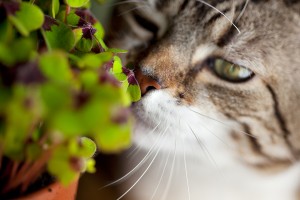In most cases, people who love their animals also love their houseplants. Houseplants breathe life into a home just like owning a cat does. It seems both pets and houseplants go hand-in-hand, but in reality they can be a deadly combination if the owner is not aware of which plants are toxic to their furry friends.
Any cat owner who also dabbles in gardening or owns houseplants should familiarize themselves with the list below. It’s a surprising list to say the least. Many very common and useful plants are on this list. Even the Aloe Vera plant, known for its medicinal value as a topical treatment for cuts and burns, is poisonous to cats. Even more surprising is that tomato and pea plants are toxic to cats as well. It’s a scary feeling to read this list and count the number of common plants lying around the house just waiting to poison the beloved feline of the home.
1. Aloe Vera - Symptoms: Vomiting, tremors, diarrhea, anorexia, depression, and a change in the color of urine.
2. Asparagus Fern - Symptoms: Allergic dermatitis, vomiting, abdominal pain, and diarrhea.
3. Baby’s Breath - Symptoms: Vomiting and diarrhea.
4. Begonia - Symptoms: Irritation and burning of the oral cavity, excessive drooling, vomiting, and difficulty swallowing.
5. Bird of Paradise Flower - Symptoms: Mild nausea, vomiting, and drowsiness.
6. Caladium (also known as Elephant Ears or Taro) – Symptoms: Irritation and burning of the oral cavity, excessive drooling, vomiting and difficulty swallowing.
7. Cardboard Palm - Symptoms: Liver failure, excessive thirst, bruising, melena, hemorrhagic gastroenteritis, vomiting, pathy, liver damage, liver failure and death.
8. Carnation - Symptoms: Mild gastrointestinal signs and mild dermatitis.
9. Ceriman - Symptoms: Irritation and burning of the oral cavity, vomiting, excessive drooling, vomiting, and difficulty swallowing.
10. Charming Dieffenbachia - Symptoms: Irritation and burning of the oral cavity, vomiting, excessive drooling, and difficulty swallowing.
11. Chinese Jade - Symptoms: Nausea and retching.
12. Chrysanthemum - Symptoms: Vomiting, diarrhea, hyper-salivation, in-coordination, and dermatitis.
13. Coleus - Symptoms: Vomiting blood, bloody diarrhea, depression, and anorexia.
14. Corn Plant - Symptoms: Vomiting blood, depression, anorexia, hyper-salivation, and dilated pupils.
15. Cyclamen - Symptoms: Salivation, vomiting, diarrhea, cardiac arrhythmia, seizure, and death.
16. Daffodil (also known as narcissus) – Symptoms: Vomiting, excessive salivation, diarrhea, convulsions, low blood pressure, tremors, and cardiac arrhythmia.
17. Dahlia - Symptoms: Mild gastrointestinal signs and mild dermatitis.
18. Dieffenbachia - Symptoms: Irritation and burning of the oral cavity, excessive drooling, vomiting, and difficulty swallowing.
19. Everlasting Pea (also known as Sweet Pea) – Symptoms: Weakness, lethargy, pacing, head pressing, tremors, seizures, and possibly death.
20. Fig (also known as Indian Rubber Plant) – Symptoms: Dermatitis, oral irritation, excessive salivation, and vomiting.
21. Flamingo Flower - Symptoms: Irritation and burning of the oral cavity, excessive drooling, vomiting, and difficulty swallowing.
22. Florida Beauty - Symptoms: Dilated pupils, difficulty breathing, increased heart-rate, abdominal pain, vomiting, depression, in-coordination, weakness, and drooling.
23. Hyacinth, both Garden Hyacinth and Water Hyacinth are toxic to dogs and cats. Symptoms: Vomiting, diarrhea, dermatitis, and allergic reactions.
24. Gladiola - Symptoms: Vomiting, drooling, lethargy, diarrhea.
25. Hellebore - Symptoms: Drooling, abdominal pain, diarrhea, colic, and depression.
26. Hosta - Symptoms: Vomiting, diarrhea, depression.
27. Ivy is yet another botanical genre that should be avoided by pet owners. Many different species of ivy are toxic to both dogs and cats. The variations to especially watch for are the Branching Ivy, English ivy, Devil’s Ivy (also known as Golden Pothos), andSweetheart Ivy - Symptoms: Irritation and burning of the oral cavity, excessive drooling, vomiting and difficulty swallowing.
28. Jade Plant (also known as Chinese or Japanese Rubber Plant) – Symptoms: Vomiting, depression, ataxia, and slow heart rate.
29. Kiss-me-quick - Symptoms: Tremors, seizures (for several days), diarrhea, vomiting, excessive salivation, lethargy, in-coordination, and coughing.
30. Lacy Tree Philodendron - Symptoms: Irritation and burning of the oral cavity, excessive drooling, vomiting, and difficulty swallowing.
31. Lily Family – Nearly all lilies are toxic to both dogs and cats. The variations to especially watch for are Amaryllis, Arum Lily, Asian Lily, Stargazer Lily, Barbados Lily, Clivia Lily, Desert Azalea, Easter Lily, Giant Dracaena (also known as the Palm Lily), Lily-Of-The-Valley, Orange Day Lily, Tiger Lily, Trumpet Lily, and Wood Lily. With so many different species of lilies that are toxic to cats and dogs alike, it’s best for pet owners to simply avoid lilies altogether. Symptoms: Diarrhea, depression, vomiting, abdominal pain, hyper-salivation, anorexia, tremors, excessive drooling, irritation to oral cavity, difficulty swallowing, cardiac arrhythmia, convulsions, kidney failure, and death.
32. Mistletoe - Symptoms: Gastrointestinal problems, cardiovascular collapse, difficulty breathing, slow heart rate, odd behavior that would point to signs of hallucinations, vomiting, and diarrhea.
33. Nephthytis - Symptoms: Irritation and burning of the oral cavity, excessive drooling, vomiting, and difficulty swallowing.
34. Orange - Symptoms: Vomiting, diarrhea, depression, and sometimes photo-sensitivity.
35. Pencil Cactus - Symptoms: Irritation of the oral cavity and vomiting.
36. Poinsettia - Symptoms: Irritation of the oral cavity and vomiting.
37. Primrose - Symptoms: Mild vomiting.
38. Spring Parsley - Symptoms: Photo-sensitivity, ulcerative dermatitis, exudative dermatitis, and ocular toxicity.
39. Tomato Plant - Symptoms: Excessive drooling, loss of appetite, diarrhea, vomiting, drowsiness, depression, confusion, bradycardia (slow heart rate), dilated pupils, weakness, and change in behavior.
40. Tulip - Symptoms: Vomiting, depression, diarrhea, and excessive drooling.
41. Yucca - Symptoms: Vomiting and diarrhea.
It should be noted that many of these plants are popular flowers used in arrangements. Even though a cat owner has taken great care to ensure their home and yard is free from these toxic plants, any flower arrangements brought into the home should also be kept out of reach of your cat.
It should never be assumed that a cat will instinctively leave a toxic plant alone. Thousands of cats are taken to the veterinarian each year on an emergency basis due to ingestion of a toxic houseplant. By becoming familiar with this list, a cat owner can rest assured their home is a safe environment for their beloved feline.


Please contribute to this article discussion and post a comment below...
Powered by Facebook Comments